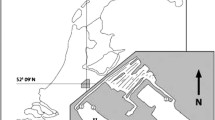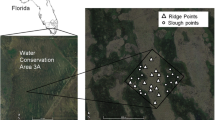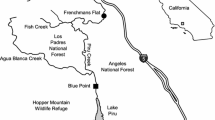Summary
The interaction of population stability and habitat permanence has a major influence on the microdistribution of freshwater snails. For two years (February 1980–January 1982), we monitored the abundance of macrophytes and the abundance and size structure of four species of macrophyte-associated freshwater snails in an English pond. Previous work (Lodge, in press) showed that two species, the pulmonate Lymnaea peregra (Mull.) and the prosobranch Valvata piscinalis (Mull.), were associated with cubmersed macrophytes, while two other species, the pulnonate Planorbis vortex (Linn.), and the prosobranch Bithynia tentaculata (Linn.), were associated with emergent macrophytes. A dramatic decline of submersed macrophytes provided a test of the hypotheses that the population stability of Lymnaea and Valvata was 1) high, and 2) an important cause of the association of those two species with submersed macrophytes.
When the submersed macrophytes declined in August 1980, >99% of the Lymnaea and about 35% of the Valvata population died. The populations of Planorbis and Bithynia were not reduced. In 1980, Lymnaea and Valvata had simple annual life cycles, but with the regrowth of submersed macrophytes in spring 1981, the Lymnaea and Valvata populations responded with early, high, and repeated reproduction with some overlap of generations. In both years, Planorbis had an annual semelparous life cycle, while Bithynia lived up to 3 years and bred iteroparously.
Following the terminology of Connell and Sousa (1983), Lymnaea exhibited low resistance to habitat disturbance but high adjustment following the disturbance. Valvata showed higher resistance than Lymnaea, and also high adjustment. Although the population stability of Planorbis and Bithynia could not be rigorously evaluated, published accounts of those species' life cycles suggest that stability, specially the adjustment component, was low. We suggest that the population stability of the four species is a major determinant of the association of Lymnaea and Valvata with the impermanent macrophyte habitat and that of Planorbis and Bithynia with the permanent macrophyte habitat.
Similar content being viewed by others
References
Aldridge DW (1982) Reproductive tactics in relation to life-cycle bioenergetics in three natural populations of the freshwater snail, Leptoxis carinata. Ecology 63:196–208
Bell G (1983) Measuring the cost of reproduction. III. The correlation structure of the early life history of Daphnia pulex. Oecologia 60:378–383
Berg K (1961) On the oxygen consumption of some freshwater snails. Verh int Verein Theor angew limnol 14:1019–1022
Boyce MS (1979) Seasonality and patterns of natural selection for life histories. Am Nat 114:569–583
Bondesen P (1950) A comparative morphological-biological analysis of the egg capsule of freshwater pulmonate gastropods. Nat Jutl 3:1–208
Brown KM (1983) Do life history tactics exist at the intraspecific level? Am Nat 121:871–879
Calow P (1978) The evolution of life cycle strategies in freshwater gastropods. Malacologia 17:351–364
Calow P (1981) Adaptational aspects of growth and reproduction in Lymnaea peregra (Gastropoda: Pulmonata) from exposed and sheltered aquatic habitats. Malacologia 21:5–13
Calow P (1983) Life-cycle patterns and evolution. In:Russell-Hunter WD (ed) The mollusca, Vol 6, Ecology. Academic Press, New York, pp 649–678
Cassie RM (1954) Some uses of probability paper in the analysis of size frequency distributions. Aust J Mar Freshwater Res 5:513–522
Choat JH, Black R (1979) Life histories of limpets and the limpetlaminarian relationship. J Exp Mar Biol Ecol 41:25–50
Clampitt PT (1975) How fast is a snails pace? Active and passive dispersal of Physa integra in Douglas Lake Michigan. Malacol Rev 8:121
Cleland DM (1954) A study of the habits of Valvata piscinalis (Muller) and the structure and function of the alimentary canal and reproductive system. Proc Malac Soc Lond 30:167–203
Connell JH, Sousa WP (1983) On the evidence needed to judge ecological stability or persistence. Am Nat 121:789–824
Cross DG, Minns CK (1969) A method of separating invertebrates from samples of aquatic vegetation. Lab Pract 18:315–316
DeCoster W, Persoone G (1970) Ecological study of Gastropoda in a swamp in the neighborhood of Ghent (Belgium). Hydrobiologia 36:65–80
Diamond JM (1982) Stream geomorphology and benthic habitat predictability as determinants of the population dynamics and life history of the snail Juga plicifera. J Freshwater Ecol 1:577–588
Dussart GBJ (1979) Life cycles and distribution of the aquatic gastropod molluscs Bithynia tentaculata (L.), Gyraulus albus (Muller), Planorbis planorbis (L.) and Lymnaea peregra (Muller) in relation to water chemistry. Hydrobiologia 67:223–239
Hart A, Begon M (1982) The status of general reproductive strategy theories, illustrated in winkles. Oecologia (Berlin) 52:37–42
Hornbach DJ, Way CM, Burky AJ (1980) Reproductive strategies in the freshwater sphaeriid clam, Musculium partumeium (Say), from a permanent and a temporary pond. Oecologia (Berlin) 44:164–170
Hubendick B (1962) Aspects on the diversity of the fresh-water fauna. Oikos 13:249–261
Hunter WR (1953) On migrations of Lymnaea peregra (Muller) on the shores of Loch Lomond. Proc Royal Soc of Edinburgh LXV:84–105
Hunter WR (1961) Annual variations in growth and density in natural populations of freshwater snails in the west of Scotland. Proc Zool Soc Lond 136:219–253
Hyman LH (1967) The invertebrates Vol VI, Mollusca I. McGraw-Hill, New York
Jassby AD, Goldman CR (1974) A quantitative measure of succession rate and its application to the phytoplankton of lakes. Am Nat 108:688–693
Kunii H, Maeda K (1982) Seasonal and long-term changes in surface cover of aquatic plants in a shallow pond, Ojaga-ike, Chiba, Japan. Hydrobiologia 87:45–55
Lamarche AP, Legendre P, Chodorowski A (1982) Facteurs responsables de la distribution des gasteropodes dulcicoles dans le fleuve Saint-Laurent. Hydrobiologia 89:61–76
Lewontin RC (1965) Selection for colonizing ability. In: Baker HG, Stebbins GL (eds) The genetics of colonizing species. Academic Press, New York, p 588
Lilly MM (1953) The mode of life and the structure and functioning of the reproductive ducts of Bithynia tentaculata (L.). Proc Malac Soc Lond 30:87–100
Lodge DM (1982) Factors effecting the distribution of gastropod species in a eutrophic pond. D Phil Thesis, University of Oxford
Lodge DM (1985) Macrophyte-gastropod associations: observations and experiments on macrophyte choice by gastropods. Freshwater Biol (in press)
Mason CF (1978) Artificial oases in a lacustrine desert. Oecologia (Berlin) 36:93–102
Mason CF, Bryant RJ (1975) Changes in the ecology of the Norfolk broads. Freshwater Biol 5:257–270
McKee PM, Mackie GL (1981) Life history adaptations of the fingernail clams Sphaerium occidentale and Musculium securis to ephemeral habitats. Can J Zool 59:2219–2229
McMahon RF (1983) Physiological ecology of freshwater pulmonates. In: Russell-Hunter WD (ed) The mollusca, Vol 6, Ecology. Academic Press, New York, pp 359–430
Morgan NC (1970) Changes in the fauna and flora of a nutrient enriched lake. Hydrobiologia 35:545–553
Parry GD (1982) The evolution of the life histories of four species of intertidal limpets. Ecological Monographs 52:65–91
Parsons PA (1983) The evolutionary biology of colonizing species. Cambridge University Press, p 262
Phillips GL, Eminson D, Moss B (1978) A mechanism to account for macrophyte decline in progressively eutrophicated freshwaters. Aquat Bot 4:103–126
Pinel-Alloul B, Magnin E (1971) Cycle vital et croissance de Bithynia tentaculata L. (Mollusca, Gastropoda, Prosobranchia) du Lac St. Louis près de Montreal. Can J Zool 49:759–766
Russo AR (1978) Some ecological observations on a permanent pond in southern England: primary production and planktonic seasonal succession. Hydrobiologia 60:33–48
Sousa WP (1980) The response of a community to disturbance: the importance of successional age and species' life histories. Oecologia (Berlin) 45:72–81
Southwood TRE (1977) Habitat, the templet for ecological strategies? J Anim Ecol 46:337–365
Stearns SC (1980) A new view of life-history evolution. Oikos 35:266–281
Stearns SC (1984) The effects of size and phylogeny on patterns of covariation in the life history traits of lizards and snakes. Am Nat 123:56–72
Tashiro JS (1980) Bioenergetic background to reproductive partitioning in an iteroparous population of the freshwater prosobranch Bithynia tentaculata. Ph D Dissertation, University of Syracuse, New York
Tashiro JS, Colman SD (1982) Filter feeding in the freshwater prosobranch snail Bithynia tentaculata: bioenergetic partitioning of ingested carbon and nitrogen. Am Midl Nat 197:114–132
Tonn WM, Magnuson JJ (1982) Patterns in the species composition and richness of fish assemblages in northern Wisconsin lakes. Ecology 63:1149–1166
Tsikhon-Lukanina EA (1961) On the problem of the filtration feeding method of Bithynia tentaculata L. and Valvata piscinalis Muller. Byull Inst Biol Vodokhr 10:28–30
Vincent B, Vaillancourt G (1981) Methode de determination de l'age, longevite et croissance annuelle de Bithynia tentaculata L. (Gastropoda: Prosobranchia) dans le Saint-Laurent (Quebec). Can J Zool 59:982–985
Vincent B, Gaucher M (1983) Variations de la fécondité et de la structure des populations chez Bithynia tentaculata L. (Gastropoda: Prosobranchia). Can J Zool 61:2417–2423
Way CM, Hornbach DJ, Burky AJ (1980) Comparative life history tactics of the sphaeriid clam, Musculium partumeium (Say), from a permanent and a temporary pond. Am Midl Nat 104:319–327
Webster JR, Gurtz ME, Hains JJ, Meyer JL, Swank WT, Waide JB, Wallace JB (1983) Stability of stream ecosystems. In: Barnes JR, Minshall GW (eds) Stream ecology, Plenum Press, pp 355–395
Wortley JS (1974) The role of macrophytes in the ecology of gastropods and other invertebrates in the Norkfolk Broads. Ph D Thesis, School of Biological Sciences, University of East Anglia
Young MR (1975) The life cycles of six species of freshwater molluscs in the Worchester-Brimingham Coral. Proc Malac Soc Lond 41:533–548
Author information
Authors and Affiliations
Rights and permissions
About this article
Cite this article
Lodge, D.M., Kelly, P. Habitat disturbance and the stability of freshwater gastropod populations. Oecologia 68, 111–117 (1985). https://doi.org/10.1007/BF00379482
Received:
Issue Date:
DOI: https://doi.org/10.1007/BF00379482




